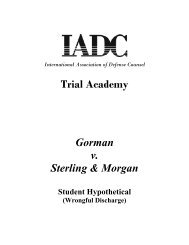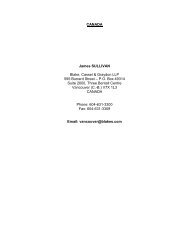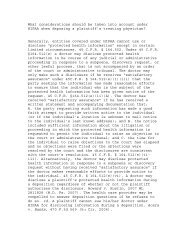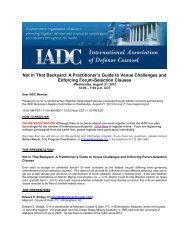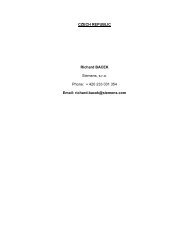Defense Counsel Journal - International Association of Defense ...
Defense Counsel Journal - International Association of Defense ...
Defense Counsel Journal - International Association of Defense ...
You also want an ePaper? Increase the reach of your titles
YUMPU automatically turns print PDFs into web optimized ePapers that Google loves.
Page 460 DEFENSE COUNSEL JOURNAL–October 2012assessed a punitive damage multiplier ‘foreach $1.00 <strong>of</strong> actual damages,’” invarying amounts for the differentdefendants involved. 40 Ultimately, thejudgments in the trial court werevacated. 41 The latter proceedings,however, did not attack the use <strong>of</strong> amultiplier. Rather, the appeals court tookissue with the lower court’s use <strong>of</strong>statistical methods to extrapolate awardsfor class members based on awardsdetermined for sample plaintiffs. 42The Fifth Circuit considered the use<strong>of</strong> a punitive damage multiplier again inWatson v. Shell Oil Co. 43 AlthoughWatson was later reversed en banc, 44 thecase provides further insight into the use<strong>of</strong> a punitive damage multiplier in a masstort action. Watson arose out <strong>of</strong> anexplosion at a manufacturing facility thatcaused extensive damage throughout theplant and surrounding communities. 45The court posited that where thedefendant’s culpability is determined inconnection with one single event in amass-disaster context, there is likely to beless variance between punitive damageawards with respect to different plaintiffsand, therefore, a multiplier approach todetermine punitive damages for the entireclass may be appropriate. 46 The courtwent on to note that to the extent thatplaintiffs’ claims for punitive damages40 Id.41 See generally Cimino v. Raymark, 151 F.3d297, 335 (5th Cir. 1998).42 Id.43 Watson v. Shell Oil. Co., 979 F. 2d 1014,1016-17 (5th Cir. 1992), reversed en banc, 53F.3d 663 (5th Cir. 1994).44 Id.45 Id. at 1016-1017.46 Id. at 1019.differ, a phased trial plan that utilizes amultiplier can be refined by settingdifferent ratios or multipliers for differenttypes <strong>of</strong> claims, rather than casting asidethe method altogether. 47 A refinedapproach using different multipliers fordifferent types <strong>of</strong> claims presumablywould allow the defendants anopportunity to present defenses tailored tothe specific categories <strong>of</strong> claims withoutrequiring individual determination <strong>of</strong>punitive damages with respect to everyplaintiff. The refined approach would bemore fair to the defendants, less likely todeny defendants an opportunity to presenta defense, and would still increasejudicial efficiency.B. West VirginiaThe Supreme Court <strong>of</strong> Appeals <strong>of</strong>West Virginia discussed the use <strong>of</strong> apunitive damage multiplier in the context<strong>of</strong> a mass tobacco litigation involvingconsolidation <strong>of</strong> 1,100 individual claimsby smokers against tobacco companies. 48The court considered whether a bifurcatedtrial, where liability and a punitivedamage multiplier are determined inphase I, prior to a finding <strong>of</strong>compensatory damages for each plaintiffin phase II, violates the Due ProcessClause as interpreted by the U.S.Supreme Court in State Farm v.Campbell. 49The defendant tobacco companiesobjected to the bifurcated trial plan, andthe determination <strong>of</strong> a punitive damage47 Id. 1019 n.19.48 In re Tobacco Litigation, 624 S.E.2d 738(W.Va. 2005).49 538 U.S. 408 (2003).



